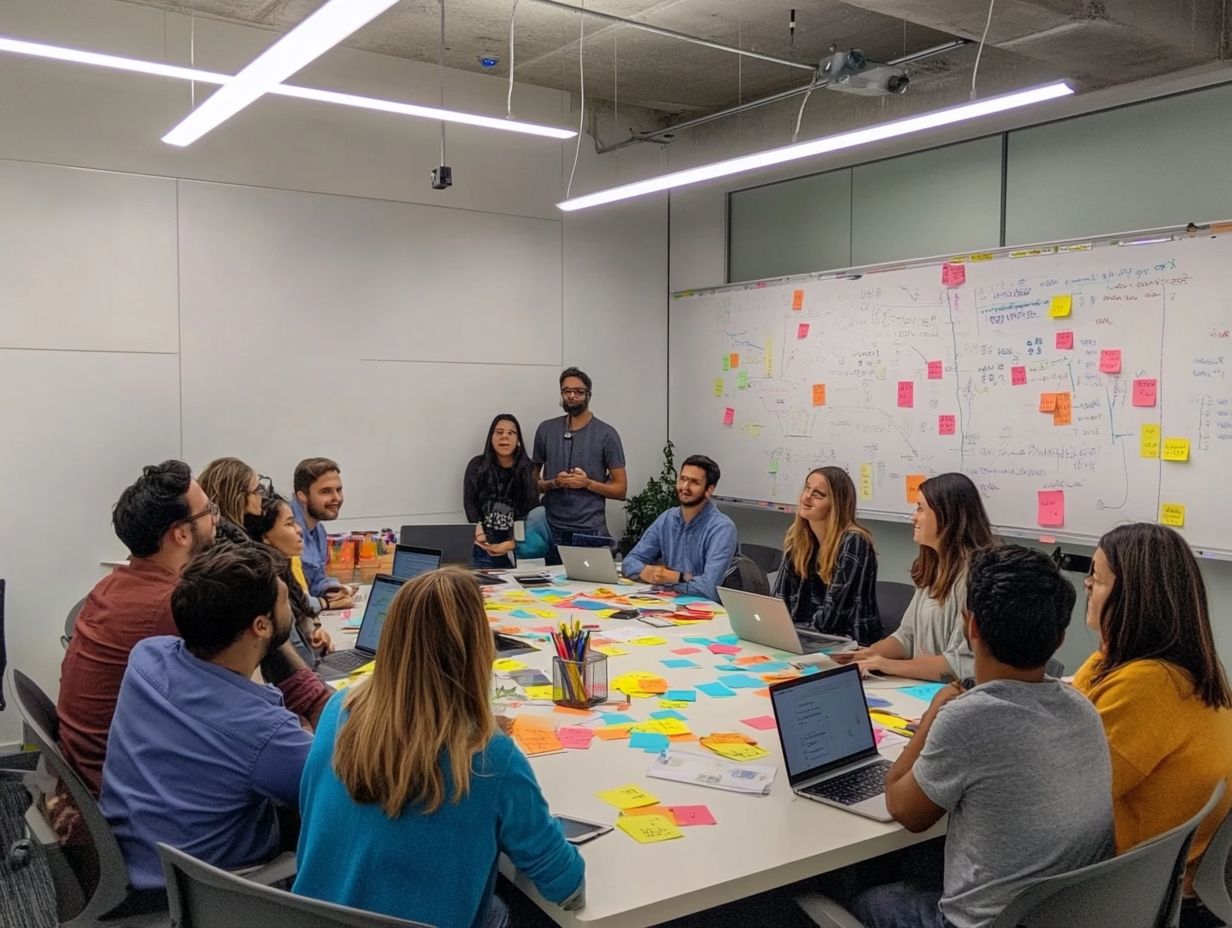Creativity in Business: Unlocking Innovation
In today’s fast-paced business landscape, creativity is not merely a luxury; it is essential for achieving success. When you embrace innovative thinking, you often find yourself outpacing competitors and adapting more effectively to change.
However, barriers to creativity can hold you back, making it crucial for you to identify and overcome these obstacles. This article delves into the vital role creativity plays in driving business success, offering you strategies to foster a culture of innovation as well as insights on how to measure creative outcomes.
Explore with us the transformative power of creativity in the workplace and gain a glimpse into the emerging trends that are shaping the future of business.
Contents
- Key Takeaways:
- The Importance of Creativity in Business
- Barriers to Creativity in Business
- Ways to Foster Creativity in the Workplace
- Using Creativity for Business Growth
- Measuring and Evaluating Creative Success
- The Future of Creativity in Business
- Frequently Asked Questions
- What is the importance of creativity in business?
- How can creativity be fostered in the workplace?
- What are some common barriers to creativity in business?
- How can businesses use creativity to improve their bottom line?
- What are some ways to incorporate creativity into everyday business practices?
- How can businesses measure the impact of creativity on their success?
Key Takeaways:

Creativity is essential for business success as it drives innovation, helps to solve problems, and sets businesses apart from competitors. Exploring the essentials of creative thinking in business can further enhance these skills.
Identifying and overcoming barriers to creativity in the workplace can unlock new ideas and opportunities for growth.
Fostering a culture of innovation and supporting employee creativity are key to utilizing creativity for business growth and measuring creative success.
The Importance of Creativity in Business
Creativity is crucial for your business journey don’t underestimate its power! It fuels innovation, sharpens strategic thinking, and enhances problem-solving abilities, all of which elevate employee engagement and leadership effectiveness.
In today s fast-paced marketplace, embracing creativity is vital to adapt to shifting consumer demands, fostering a customer-centric approach, and retaining a competitive edge.
This means cultivating a culture of collaboration and teamwork while encouraging diverse perspectives that can spark groundbreaking solutions and unique ideas.
Effective communication and robust planning to handle unexpected challenges are crucial elements in harnessing creativity, enabling your teams to navigate challenges with agility and finesse.
Why Creativity is Essential for Business Success
Creativity is a cornerstone of your business success, giving you the power to craft innovative solutions and maintain that all-important competitive edge in the marketplace.
By cultivating a culture that champions creative thinking, you can elevate your products and services while also developing strong strategies that anticipate market shifts.
This proactive stance on risk enables you to pivot swiftly when challenges arise, ensuring both stability and longevity for your organization.
Involving your employees in the creative process fosters a sense of ownership and motivation, which naturally leads to higher levels of productivity.
Ultimately, these innovative practices can significantly boost your overall business performance and drive sustained growth, positioning your organization as a leader in your industry.
Barriers to Creativity in Business
Barriers to creativity in business frequently arise from deeply ingrained cultural norms, a hesitance to embrace risk, and a resistance to organizational change.
These factors can significantly stifle innovation and diminish problem-solving capabilities, ultimately limiting your potential for growth and success.
Identifying and Overcoming Obstacles
Identifying and overcoming obstacles to your creativity demands a systematic approach that highlights teamwork and collaboration in the pursuit of effective solutions.
You may encounter hurdles such as rigid hierarchies, inadequate communication, and a fear of failure that stifles the innovative spirit. These barriers can impede your creative process and lead to stagnation.
To address these challenges, it s essential to foster an environment where every team member feels empowered to share their ideas without hesitation. Encouraging open dialogues through brainstorming sessions and workshops can cultivate a sense of collective ownership over creative endeavors.
Implementing cross-functional teams brings diverse perspectives, driving innovative problem-solving techniques even further. By prioritizing these strategies, you can help create a dynamic atmosphere that nurtures imaginative thinking and collaboration, allowing creativity to flourish.
Start fostering creativity in your team today and watch your business thrive!
Ways to Foster Creativity in the Workplace

Fostering creativity in the workplace means building a culture that values innovation and supports employee engagement.
Encourage unique ideas through brainstorming and collaboration. This creates an environment where creativity thrives and individuals feel empowered to contribute.
Creating a Culture of Innovation
A culture of innovation starts with strong leadership that promotes effective communication.
In a trusting environment, employees feel empowered to share their ideas without fear of criticism. This openness sparks creative thinking and enhances collaboration across teams.
By valuing diverse perspectives, strong leadership inspires dynamic brainstorming sessions and groundbreaking solutions.
Leaders who practice transparent communication show commitment to innovation, creating an atmosphere where experimentation is encouraged and mistakes are valuable learning opportunities.
This blend of leadership and effective communication creates a vibrant workplace culture that drives sustained innovation.
Encouraging and Supporting Employee Creativity
Supporting your employees’ creativity hinges on creating an environment where they feel ownership and can engage in meaningful work.
Implement targeted strategies that empower your teams to explore their creative potential.
Providing access to resources like workshops, online courses, and brainstorming sessions enables employees to hone their skills and develop their talents.
Encouraging collaboration across different departments can spark fresh ideas, enriching the creative process.
Regular feedback and recognition are essential for reinforcing positive contributions, making employees feel truly valued.
Ultimately, creating opportunities for skill development and sparking open communication will cultivate a culture where imaginative solutions can thrive, enhancing engagement and productivity.
Using Creativity for Business Growth
Using creativity for business growth means embracing innovative strategies that align seamlessly with a customer-centric approach, effectively meeting market demands.
Innovation Strategies and Implementation
Innovation strategies require careful attention to effectively implement creative ideas, ensuring teams retain a competitive edge in the fast-paced business landscape.
It’s not enough to generate novel concepts; you must also adapt swiftly to shifting market demands.
Agile teams, marked by their flexibility and collaboration, play a crucial role in harnessing creativity and turning it into actionable solutions.
By cultivating a culture that encourages experimentation and views failure as a learning opportunity, your organization can unlock significant rewards.
When you successfully integrate creativity into your strategies, you set your business apart from competitors, paving the way for sustained growth and enduring relevance.
Measuring and Evaluating Creative Success

Measuring and evaluating creative success requires identifying key metrics that provide valuable insights into the effectiveness of your creative initiatives and their impact on business outcomes.
By focusing on these metrics, you can better understand the true impact of your efforts and drive meaningful results for your organization.
Key Metrics and Indicators
Key metrics and indicators for measuring your business’s creative success encompass both numbers you can count and feedback, offering you a holistic view of how effective your creative efforts truly are.
These metrics can span engagement rates and conversion figures to consumer feedback and assessments of brand perception.
On the numbers side, measures like return on investment (ROI), which means the money you earn compared to what you spend, and sales growth can unveil the tangible impacts of your work.
Meanwhile, feedback assessments such as customer satisfaction surveys and social media sentiment analysis dive deeper into how your audience is truly responding.
By analyzing these varied data points, you can make informed decisions about future creative initiatives. This ensures that your resources are allocated wisely and your strategies evolve to meet shifting market demands.
This balanced approach boosts performance and fosters a culture of innovation that aligns with consumer needs.
The Future of Creativity in Business
The future of creativity in business is intricately shaped by emerging trends and predictions. These emphasize the evolving significance of cultural norms and learning opportunities in driving innovation.
Trends and Predictions
Current trends and predictions indicate that creativity is set to become an essential element of your business strategy. It will propel innovation and ensure long-term success.
As you recognize the importance of creative solutions in tackling complex challenges, you ll likely start rethinking traditional frameworks in favor of more agile, interdisciplinary approaches.
This transformation may lead to a heightened focus on collaborative environments where diverse teams can brainstorm and prototype with ease.
The rise of digital tools and platforms will further enhance your brainstorming processes. These tools enable a seamless exchange of ideas regardless of geographic boundaries.
These advancements not only nurture innovative strategies but also reshape your organizational practices. This makes them more adaptable and resilient in today s rapidly evolving market landscape.
Frequently Asked Questions
What is the importance of creativity in business?

Creativity in business is essential for unlocking innovation and driving success. It allows companies to stand out in a competitive market and explore how creativity can drive business innovation while coming up with new and innovative ideas.
It also helps solve complex problems in unique ways. Without creativity, businesses risk becoming stagnant and falling behind their competitors.
How can creativity be fostered in the workplace?
To foster creativity in the workplace, businesses can encourage a culture of experimentation and open-mindedness. They should provide opportunities for employees to brainstorm and share ideas.
Supporting risk-taking and learning from failures is crucial. It’s also important to create a diverse and inclusive environment where all team members feel comfortable expressing their thoughts.
What are some common barriers to creativity in business?
- Fear of failure
- Rigid and hierarchical workplace culture
- Lack of resources or time
- Resistance to change
These barriers can stifle creativity and prevent businesses from unlocking innovation. However, they can be overcome by addressing them head-on and implementing strategies to promote creativity.
How can businesses use creativity to improve their bottom line?
Unlock creativity, and watch your profits soar! It can help companies develop new and innovative products or services.
Creativity also improves operational processes, attracts and retains customers, and differentiates businesses in the market. Additionally, creative problem-solving can save time and money by finding more efficient and effective solutions.
What are some ways to incorporate creativity into everyday business practices?
There are many simple ways to incorporate creativity into everyday business practices. Businesses can set aside time for brainstorming sessions and encourage employees to take breaks to recharge their creative energy.
Providing opportunities for cross-functional collaboration and seeking input from customers and stakeholders are also beneficial. It’s important to continuously challenge and question current processes and strategies to find opportunities for improvement.
Start implementing these creative strategies today for a brighter business future!
How can businesses measure the impact of creativity on their success?
Have you ever wondered how creativity fuels business success? Measuring its impact can be challenging, but there are important signs to consider.
Look at customer feedback and satisfaction, employee engagement, and how long employees stay with the company. Revenue growth and the number of new ideas generated also matter.
Continuously tracking these metrics helps you understand how creativity influences your business.






